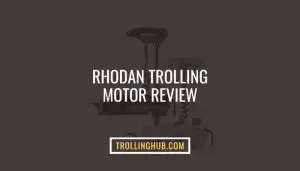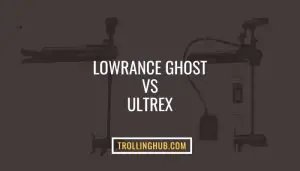If you are a boat guy, you probably have an idea of how a trolling motor functions. You know that if it is not deep enough below water, it may emerge above the surface or cavitate and if it is too deep underwater, then it may scrape the seabed, especially on shallow water bodies, or even unearth obstacles underwater. Faced with this dilemma, many boat lovers have been asking us, how deep should my trolling motor be in the water?
In this article, we are going to answer that question and many more so that you can enjoy a great boating experience.
Best Depth for a Trolling Motor?
The shaft length of a trolling motor is important for enhancing control of your boat. So, if the shaft is too long and the water is too shallow, you may face continuous problems while if the shaft is too short, the motor may not be properly submerged in water, especially during adverse or rough conditions.
Striking the right length will ensure a secure and hassle-free boating experience. Choosing the right shaft length also prevents the motor from cavitating, producing a fish-spooking sound.
The general rule is that the top of the motor should always be submerged at 12 inches. Choosing shaft length is more important, especially when it comes to transom-mount motors and bow-mount motors.
The majority of transoms are similar in terms of distance to the water, but in the case of the bow-mounted motors, you will find greater variation when it comes to shaft length requirements.
Factors That Depends on how deep should your trolling motor be in the water
There are a few factors that will determine how deep your trolling motor should be underwater, some of them are discussed below.
Bow-mount motors
If you decide to go for a bow-mounted trolling motor, you don’t have to worry about how deep the motor should be underwater because most of them are often spring-loaded to allow them to swing away in case of an impact.
Shaft length
Measure the distance from the transom to the water or where the shaft is attached on the deck to the water, then add 20 inches in case of Minn Kota or 16 inches for MotorGuide and choose the next shortest measurement.
Nature of water
If you are boating on rougher waters, we recommend getting a longer trolling shaft so that the prop will stay around 6 inches underneath the water surface when the boat pitches and reels. You can also fine-tune the vertical position of the motor with some adjustments on the mount.
Height of the stern or bow
The length of the shaft of your trolling motor is also impacted by the height of the stern or bow. The longest shafts are suitable for deep V boats.
Short lengths are usually adequate for canoes and small boats.
Can You Run a Trolling Motor Out of Water
Ideally, you should not run your trolling motor out of water because of safety reasons, but many boat users are wondering if there are circumstances that can necessitate running it out of the water, for instance, instances such as testing, and if so, how long can the trolling motor run out water.
However, it comes down to the type of motor – electric or gas-powered motor. In the case of an electric motor, you can run it out of water for about a minute while a gas-powered motor can last no longer than a few sentences.
Both electric and gas-powered motors depend on the water for cooling, and thus will not last long out of water.
So maybe when testing the motor out should you run it out of the water, but should not run for more than a couple of seconds.
Can a trolling motor shaft be too long
A trolling motor shaft can be too long, but this means you risk your propeller hitting and damaging things at the bottom or reducing the ability of the propeller to stow the motor correctly.
A too-long shaft can also damage the rest of your motor as well as the environment and marine life below the water.
So as much as a trolling motor shaft can be too long, there are many risks that come with this and you should always use a short trolling motor shaft to avoid the issues mentioned above.
A short trolling motor can function just as a long trolling motor, but will not damage or hit things below.
Can you adjust the depth of a trolling motor
You can lower or raise the depth of a trolling motor to adjust its depth. However, do not set the depth so low to the point that it compresses the coiled cable because the friction can damage the cable when the motor runs and may cause unpredicted movement when the anchor lock is engaged.
Most trolling motors come with a manual for adjusting the depth or length, so make sure you consult the manual before embarking on this process, especially if you have never done this before.
Nevertheless, not all trolling motors can be adjusted. For instance, if you want a longer trolling shaft than what you currently have, it will make economic sense to just buy a new trolling shaft or trolling motor.
It is difficult to make a short trolling motor shaft longer since you can’t extend the cables that run inside the shaft.
Can I Shorten the Shaft on my Trolling Motor
We have seen that you can adjust the depth of a trolling motor, but can you shorten the length?
In case your trolling motor shaft is not adjustable but you want to shorten it, you can do so carefully so as not to damage the wires inside.
But then again, not all models’ trolling motor shafts can be shortened. In fact, just Endura, Traxxis, Endura Max, PowerDrive & Riptide PowerDrive, Riptide Transom, or Terrova & Riptide Terrova models can be shortened.
Otherwise, you will require massive parts or software updates to shorten a trolling motor shaft of any other model, which can be extremely costly.
Moreover, you can also temper with the warranty on the product, so if you must, make sure the process is done by a licensed and authorized service center.
Final Thoughts
There you go! Some useful information you need to know about a trolling motor shaft. Setting and adjusting your trolling motor shaft at the right length and depth will enable it to function correctly as well as reduce the risk of damage.



